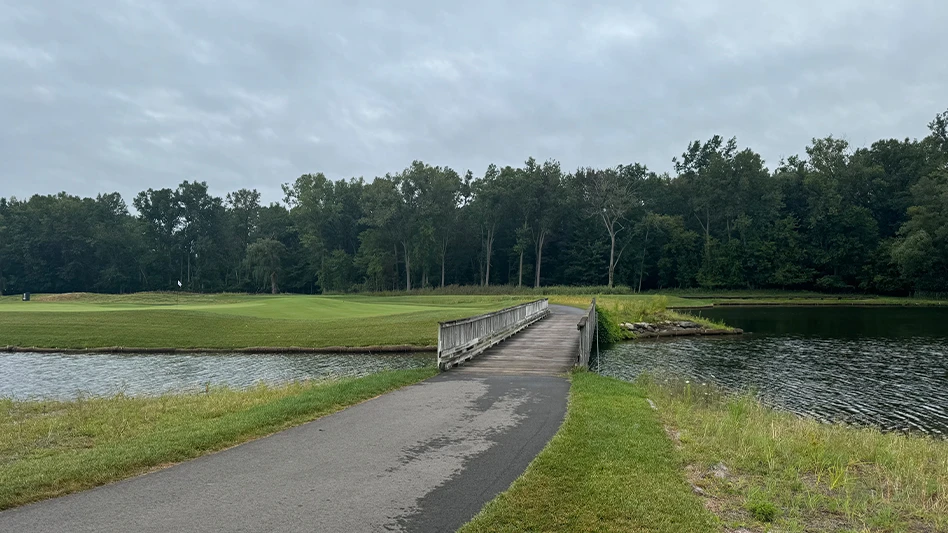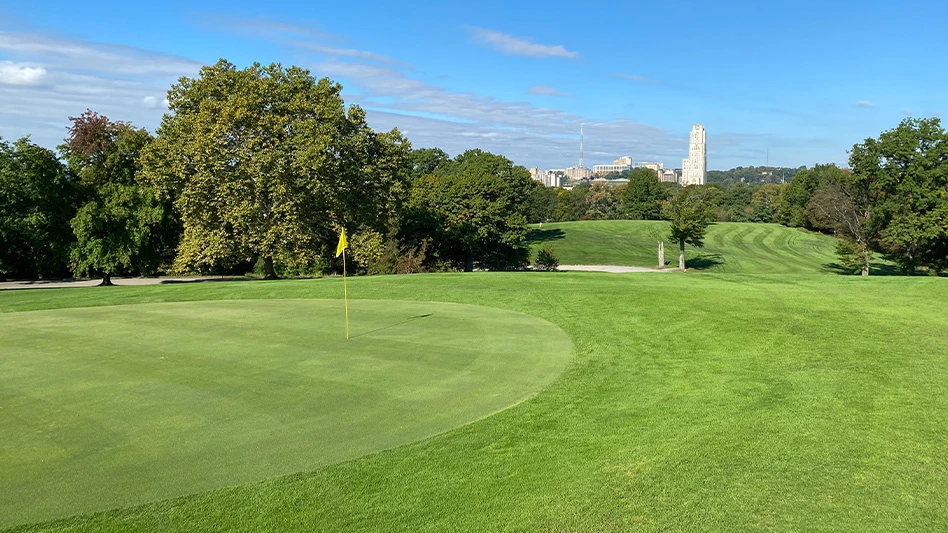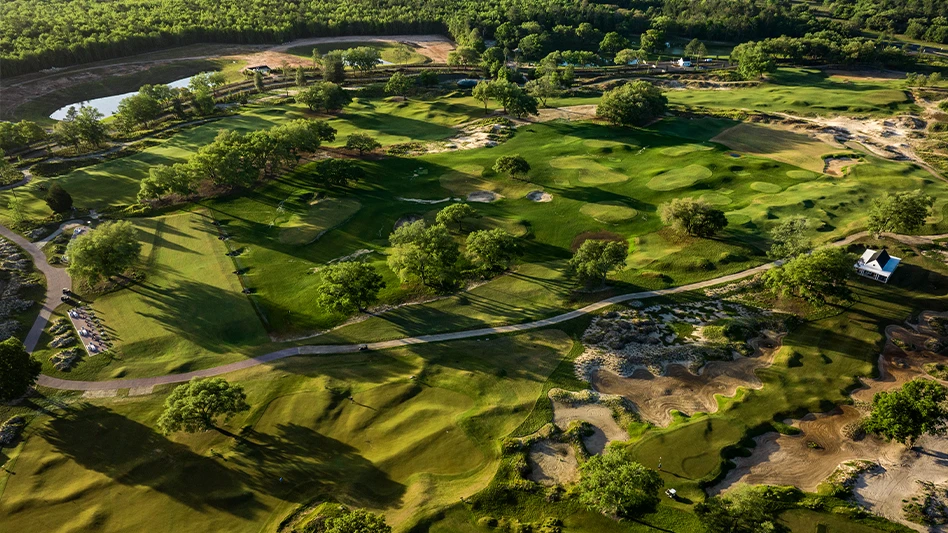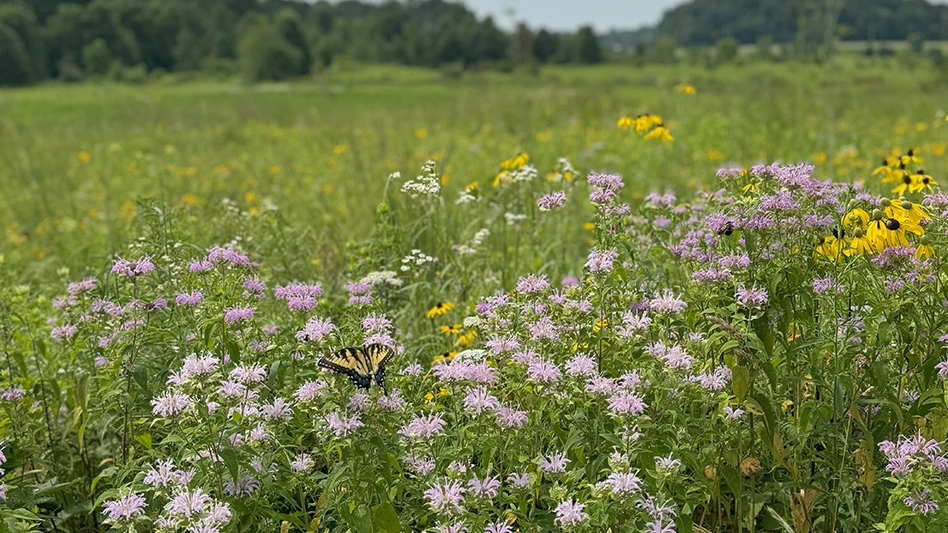
Kelsie Horner
After 10 years of concepts, approval and construction, Michigan’s Pine Lake Country Club has reopened following a full-course renovation. The private course in West Bloomfield Township opened in July after architect Drew Rogers worked alongside superintendent Terry Poley to bring the plan to life.
Rogers, the owner of JDR Design Group, first visited the Willie Park Jr.-designed course in 2013, and was officially engaged in 2014, when he created a master plan. “Then it was just a matter of getting it through to the members, looking at funding, looking at trying to convince some of the naysayers that this is the right thing to do,” Poley says. “There was a lot of pushback initially on it.”
The biggest pushback from members was the idea of closing the par-72 course for a year. The plan officially passed in 2016, and the plan was approved with funding in 2021.
Poley says the course prior to the construction could have been architecturally confusing for golfers, as it held design touches from Park, Robert Von Hagge, Jerry and Bruce Matthews, and Craig Schreiner. “The old course was kind of a mix up,” Poley says. “They've been touched a lot, and there were a lot of different things going on.”
The course can now be described as homogenous, with width and options available to players. “You’ve taken a flat piece of land and turned it into something that’s just really, really cool,” Poley adds. “And it’s something that was built correctly.”
The course was built to last, no skimping out on any resources. Poley helped choose the best fitting contractors, materials and products. Material was also chosen with sustainability in mind.
“The fact is that the planet is getting hotter, and you have grasses like annual bluegrass, for example … it doesn’t perform well in the heat,” Poley says. “It needs a lot of food. It needs a lot of fungicides, shallow rooted, it needs a lot of water. And those are all things that we don’t need to put into the Earth every day.”
Poley chose a Flagstick and Macdonald blend of creeping bentgrass on the fairways, and 007XL creeping bentgrass for the greens. “We’ve noticed that we’re putting almost no fungicides on the fairways. And, I mean, that’s huge,” he says.
For Poley, dealing with non-turf related tasks and decisions was testing. Poley, a Michigan State alumnus, handled a lot of items he didn’t learn in turf school. Part of rebuilding a course involves working with permits, banking and budgeting.
“There’s always a ton of stuff that superintendents are asked to do that is outside of their area of expertise,” Poley says. “And I guess that’s a good thing when the membership of the club has the trust and the faith in you to do these things, but it’s not necessarily your strong suit. I’m not an environmental engineer. I’m not an attorney. So, dealing with permitting and townships and ordinances and stuff like that are a little bit of a challenge.”
Poley is excited for the course’s future, once the greens have time to mature. “It’ll take a couple years for a lot of these newer varieties of grass to really reach their full genetic potential, but once they do, then you can really start doing some cool stuff, turning off the food, turn off the water, and get them fast, get it firm, where it’s fun for everybody.”
Kelsie Horner is Golf Course Industry’s assistant editor.
Rogers, the owner of JDR Design Group, first visited the Willie Park Jr.-designed course in 2013, and was officially engaged in 2014, when he created a master plan. “Then it was just a matter of getting it through to the members, looking at funding, looking at trying to convince some of the naysayers that this is the right thing to do,” Poley says. “There was a lot of pushback initially on it.”
The biggest pushback from members was the idea of closing the par-72 course for a year. The plan officially passed in 2016, and the plan was approved with funding in 2021.
Poley says the course prior to the construction could have been architecturally confusing for golfers, as it held design touches from Park, Robert Von Hagge, Jerry and Bruce Matthews, and Craig Schreiner. “The old course was kind of a mix up,” Poley says. “They've been touched a lot, and there were a lot of different things going on.”
The course can now be described as homogenous, with width and options available to players. “You’ve taken a flat piece of land and turned it into something that’s just really, really cool,” Poley adds. “And it’s something that was built correctly.”
The course was built to last, no skimping out on any resources. Poley helped choose the best fitting contractors, materials and products. Material was also chosen with sustainability in mind.
“The fact is that the planet is getting hotter, and you have grasses like annual bluegrass, for example … it doesn’t perform well in the heat,” Poley says. “It needs a lot of food. It needs a lot of fungicides, shallow rooted, it needs a lot of water. And those are all things that we don’t need to put into the Earth every day.”
Poley chose a Flagstick and Macdonald blend of creeping bentgrass on the fairways, and 007XL creeping bentgrass for the greens. “We’ve noticed that we’re putting almost no fungicides on the fairways. And, I mean, that’s huge,” he says.
For Poley, dealing with non-turf related tasks and decisions was testing. Poley, a Michigan State alumnus, handled a lot of items he didn’t learn in turf school. Part of rebuilding a course involves working with permits, banking and budgeting.
“There’s always a ton of stuff that superintendents are asked to do that is outside of their area of expertise,” Poley says. “And I guess that’s a good thing when the membership of the club has the trust and the faith in you to do these things, but it’s not necessarily your strong suit. I’m not an environmental engineer. I’m not an attorney. So, dealing with permitting and townships and ordinances and stuff like that are a little bit of a challenge.”
Poley is excited for the course’s future, once the greens have time to mature. “It’ll take a couple years for a lot of these newer varieties of grass to really reach their full genetic potential, but once they do, then you can really start doing some cool stuff, turning off the food, turn off the water, and get them fast, get it firm, where it’s fun for everybody.”
Kelsie Horner is Golf Course Industry’s assistant editor.
Latest from Golf Course Industry
- Plotting for something different
- Tartan Talks: 106: Jeff Lawrence
- Graze, Invited partner for autonomous mowing launch at Gleneagles CC
- New grasses up north?
- From the publisher’s pen: Technology diffusion and turf
- Applications open for 2025 Syngenta Business Institute
- Smart Greens Episode 1: Welcome to the digital agronomy era
- PBI-Gordon promotes Jeff Marvin





